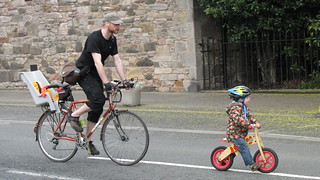Many Many issues
1) this motion fails to note the replacement of Class 156 with Class 158 on the West Highland Line - from 6 bikes to 2 per unit. Hitrans are also on this case of a 67% reduction in bike capacity
2) motion is wrong - only 2 bike spaces officially on Class 170 because there have to be 2 inviolate wheelchair spaces (no prams or luggage either (in theory)) to meet EU PRM-TSI requirements despite the fact that railways say wheelchair spaces have to be booked with 24hr notice etc, and levels of demand generally mean one or both spaces are not used on most services at present. Not sure if devolved administration can make more pragmatic rules for Scotland.
3) lifting and hanging bikes - especially on a moving train and with the cupboard arrangements on Voyagers may well be outside the envelope of safe lifting set out by HSE Manual Handling Regulations, so that any injury received might well place the TOC liable under Section 3 HSAWA 1974. I cannot lift the 19Kg Glasgow hire bikes on to the hooks on a Voyager, and a 110Kg with a 1000+Watt peak rating on the pedals I'm not exactly a weakling.
4) crap design - the illustration shows the Voyager hooks and a bike hung by the back wheel. Bikes also swing around and smash into the interior panels leaving clear evidence of the damage caused (I'd welcome videos of this, and people struggling to hang up bikes, especially on the Virgin Voyagers, where you need to turn through 180 degrees and lift from the corridor with the bike to one side and in a cramped space, with arms at full stretch
5) It is possible to have vertical bike stowage where the full weight of the bike does not need to be lifted (see the neat mini ramp used on the Bikeaway lockers) There is a design of bike stowage for trains, trams and buses, which I first saw used on Basel Trams in 1989. It uses the weight of the bike to hold it stable both in the vertical position (with the back tyre resting on the 'wall' surface on which the hook is mounted, and the option of slotting it in to a shallow channel for added stability) or in a near to horizontal position (or any angle between - which means that tandems and trikes can also use the same system - as we tested out on the IEP bike space mock-up) Using this system for vertical stowage the bike can be pulled up to the vertical position with most of the weight still resting on the back wheel, and then wheeled to the hook, with a shorts ramp made from U channel to raise the front wheel on to the hook and then locate the rear wheel through the weight of the bike settling back in the channel
6) that toilets thing. Chiltern as already done this work on the same Mk 3 carriages. The HST has 'dump' toilets which are no longer acceptable, and so one toilet is being converted to CET with a tank that as to be emptied. Practicalities and cost means that the second toilet has to be shut down. On Chiltern services the entire toilet and luggage rack has been removed to create a generous vestibule space with space for 4-6 perch or tip-up seats, and the potential to hang up 2-6 bikes on the bulkhead with the sliding door in to the saloon. The toilets and luggage racks will have to be taken out anyway for the conversion in order to fit the sliding doors and operating gear, and so putting back an arrangement like that used by Chiltern is an design already accepted. This has a benefit that Scotrail claim they need to win - reducing the dwell time at stations as passengers get on & off the train. One coaches like the Mk 3 this process is often messy as there is no 'surge space' for passengers to get ready by the doors on arrival, or get through in to the saloon as a crowd boards with luggage etc. This feature could be very valuable in keeping the station stops short and the journey times fast. It might even be worth doing a quick trial with a Chiltern carriage in Birmingham...
The replacement of the removed toilets, reportedly locked out of use reflects a low budget conversion, the power cars have 3 spaces, because that is the way they will come from GWR essentially they will have no work done on them, and the coaches will keep the same interior panels. The delivery of 5-6 bike spaces in each power car, will require the replacement of the 3 bike frame with a 5-6 bike unit - see the bike rack in the close at 2 Parkside as an example. The delivery of an open vestibule space in place of the 'closed in' space again needs to be repriced, although the panels and design has been delivered for Chiltern.
7) the Scotrail offer also promised a feature which would allow you to check for available bike spaces and book them via an app or online. Great Western is already doing this (I can explain how but not here). We need to press for this in place and working for 2018. Joost Mortier from Scotrail is doing a presentation on their smart cards, and presumably related topics on 20th April - might see what comes from this.
8) Transport Scotland underwrites (an presumably can specify some details) of the Caledonian Sleeper. I regularly arrive back on this train after a late event in Manchester or Birmingham and the Fort Willaim seated service has 31 seats and a whole van space which rarely has any of the 6 official bike spaces taken going North booking us messy and the great benefit of a train that gets you to Fort William before 10.00, and connects with the Mallaig train has never been properly promoted. If it departed by 04.30 (the combined train arrives in Edinburgh at 03.57) instead of 04.50, then it could connect with the Glasgow-Oban service for morning ferry sailings - on the islands by lunchtime - from Edinburgh. The Inverness portion is also 'almost' useful - it could arrive in time for the Ullapool coach (2 connections per day) and Stornoway by lunchtime, but for a frustrating 'gap' but it does connect with the early train for Kyle of Lochalsh.
9) note that the HST's will be delivering an hourly express service on each route - more trains than now - with additional stopping trains, which I believe will be Class 170 and be non-reservable bike spaces. With the approved use of door vestibules on the side opposite to the platform at the guard's discretion, this means that a 3-coach Class 170 could carry up to 14 bikes (16 if the PRM space can be used)
10) there is always the option of measuring current demand by doing counts on trains this summer, either by the Train staff keeping a count, or a co-ordinated survey using volunteers - much like the CTC station cycle parking survey in 2003, which covered 80% of UK stations in a month. I am aware that the morning HST that currently runs Inverness to Kings Cross can see up to 30 bikes loaded to get them to Edinburgh, where the train has 8-10 minutes in the station to unload them.
11) finally to Clause 56 of the Scottish Citylink Conditions of Carriage - which improves on the previous Clause 11(e)
56. The Company reserves the right to refuse trunks or other bulky articles, or any item heavier than 25kg (from 1st October 2013 onwards), or articles of an objectionable or dangerous nature, or which have sharp or protruding edges which may tear or damage other luggage with which it is packed within the coach. The Company is also entitled to request any passenger to open any article of luggage for inspection by the driver or other authorised employee of the Company in the presence of the passenger if, for reasons of security, the Company considers it necessary to do so. Subject to availability of accommodation, bicycles in a box/bag and skis/surfboards will be carried. Fragile items such as electronic goods, portable televisions, radios etc. will only be carried if they are of reasonable size and securely packed. The Company will not be responsible for damage to such items howsoever caused.
Pressing Citylink, and possibly Transport Scotland to deliver this as a reservable and reliable option would be a real gain to trips to Argyll, Uig, Ullapool for Stornoway, and Gills Bay for Orkney.
I'm finding this interesting and fun to follow, in 1978 (40 years from 2018 and this new introduction of HST's) I was part of the commissioning programme for the first launch of the HST's on the East Coast route....

 posts
posts
